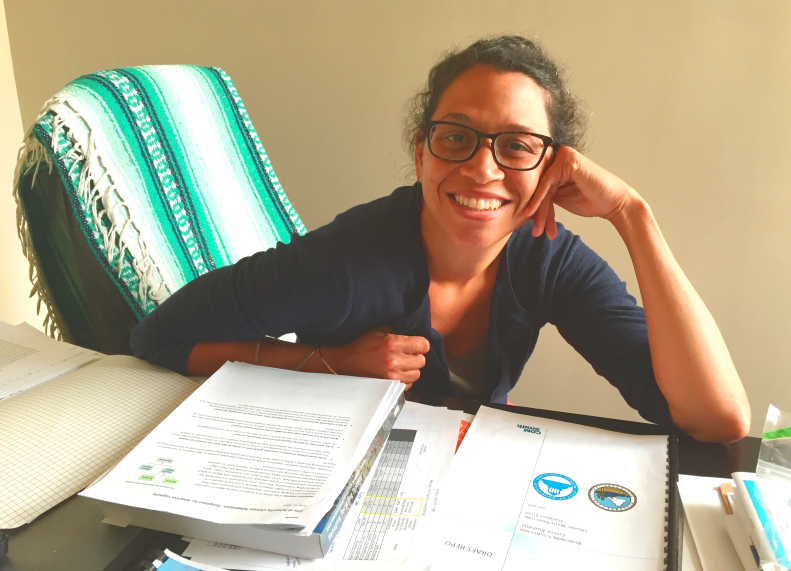Amber Weaver, the city of Asheville’s chief sustainability officer, is working ahead of time. She’s working with the year 2035 in mind, when the Buncombe County landfill will be at capacity, and toward 2050, when the city has promised to reduce its carbon footprint by 80 percent. However, with new hotels on the horizon and increased residential and commercial development affecting the region at large, the city faces a clear challenge in regard to environmental stewardship. What is being done to ensure that development doesn’t trump environment? For answers, Xpress, turned to Weaver.
Xpress: You have defined Asheville’s guiding principles of sustainability as meeting a “triple bottom line” by balancing environmental stewardship, economic growth and social responsibility (The green queen: Meet Asheville’s new chief sustainability officer). What specifically is being done to address this three-point sustainability plan?
Weaver: Asheville City Council and city staff have made it a priority to encompass the “triple bottom line” balancing environmental stewardship, economic growth and social responsibility into the folds of the city’s operations as well as Council’s strategic operating plan. Council’s strategic operating plan captures Council’s vision for Asheville, [whose] focus areas include economic growth and sustainability, affordability and economic mobility, and a high quality of life.
Since taking your position as the chief sustainability officer, what do you perceive are the most pressing issues and greatest challenges that we face as a city?
The city of Asheville has a municipal carbon footprint-reduction goal of 4 percent per year until an overall reduction of 80 percent is achieved by 2050. Presently, municipal city operations have been able to reduce [the city of Asheville’s] carbon footprint by 27 percent. However, it will take thoughtful, planned efforts by multiple departments to achieve our 80 percent goal. The Office of Sustainability is committed to these efforts and is always partnering with other city departments to explore new best practices that can be applied to Asheville.
The Office of Sustainability is also working with the city’s Planning and Urban Design Department to participate in the comprehensive planning process to update its 2025 plan. The updated plan will provide Asheville with a framework for future sustainable growth, with a focus on remaining a place where people can prosper and enjoy a livable, healthy and sustainable community for now and future generations to come. The city of Asheville will be exploring climate-adaptation planning, economic resilience and environmental stewardship — all pressing issues and challenges for our city to grow and sustain our future.
Asheville is growing quickly. Do you think that perpetual economic growth is a sustainable model in the first place? Is it possible to experience economic growth without forsaking our commitment to preserving our environmental and natural resources?
Cities across our nation are growing and finding solutions to challenges in and around urban planning. The city is beginning an 18-month process to update the comprehensive plan — the community’s vision for its future. To be successful, the update process will require input, feedback and visioning from everyone. Updating the comprehensive plan and working with city departments on the importance of preserving our environment and natural resources will help provide guiding principles on how Asheville can grow sustainably.
In 2014, recycling was not offered in public housing communities, including Pisgah View, Deaverview and Klondyke. Was this addressed in 2015? What progress has been made with the funds provided by the Community Waste Reduction grant awarded to the city to address this issue?
The city of Asheville has partnered with the Housing Authority of the City of Asheville in order to develop a public housing recycling pilot project, which has been implemented in the 280 units of the Erskine, Walton and Livingston Street communities. The city was awarded a Community Waste Reduction and Recycling grant from North Carolina Department of Environmental Quality in order to help fund this pilot project. The city’s intentions are to expand the program to all the residents within the public housing community based on the success of the Southside pilot program. The city is presently considering an application with the NCDEQ for 2016 to help expand efforts.
The city’s waste reduction goal is ambitious and hopes to curb the waste stream by 50 percent by 2035. What waste reduction strategies are being implemented to attain and move closer to this goal?
The most recent enhancements were the addition of “Big Blue,” the full-size, single-stream roll carts provided to residents, allowing larger amount of recyclables to be collected. Curbside Management has also added some additional items to the collection bin: boxed soy milk and soup cartons that you can find on the shelves at the grocery store. Both of these practices enable residents to recycle more items that otherwise might end up in the landfill.
Over the last year, the city has offered Southside public housing the opportunity to recycle. The participation and recycling rate from the community has been outstanding. Asheville is also examining the pay-as-you-throw system. PAYT is a solid-waste management service based upon the volume, or amount, the resident throws away — the more you recycle, the less amount of trash you create, and the less a resident would pay from trash service. Finally, the city of Asheville and Buncombe County partnered in an organic-waste processing feasibility study focusing on organic waste generated by residential units in the city with the objective of determining the most cost-effective means of collecting, hauling and processing organic residential waste from the city.




OMG! How are we going to do this? What happens if we fail? What about the bears?
Careful. PAYT will likely result in people dumping illegally. Not a good idea.
http://sustainnc.com